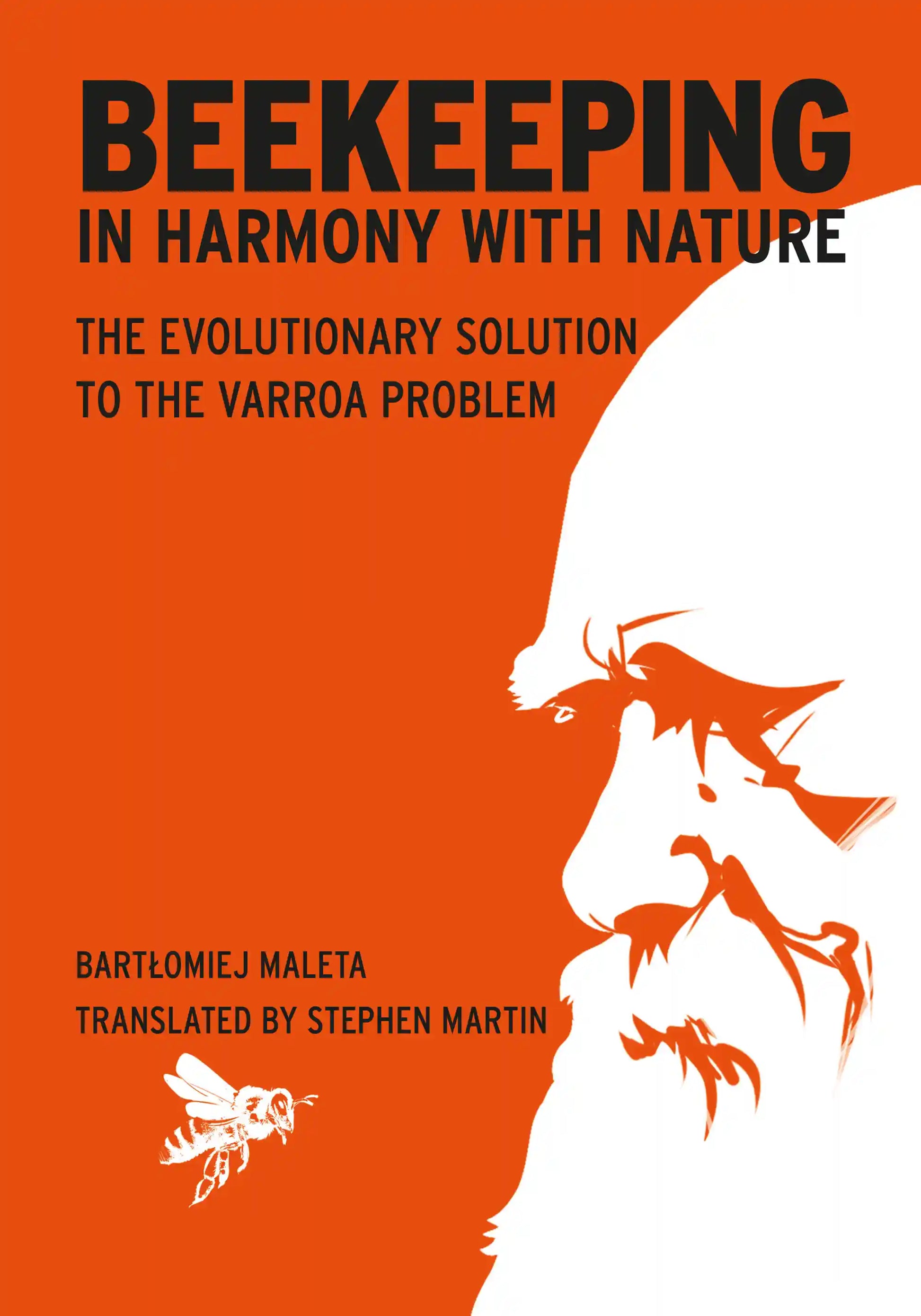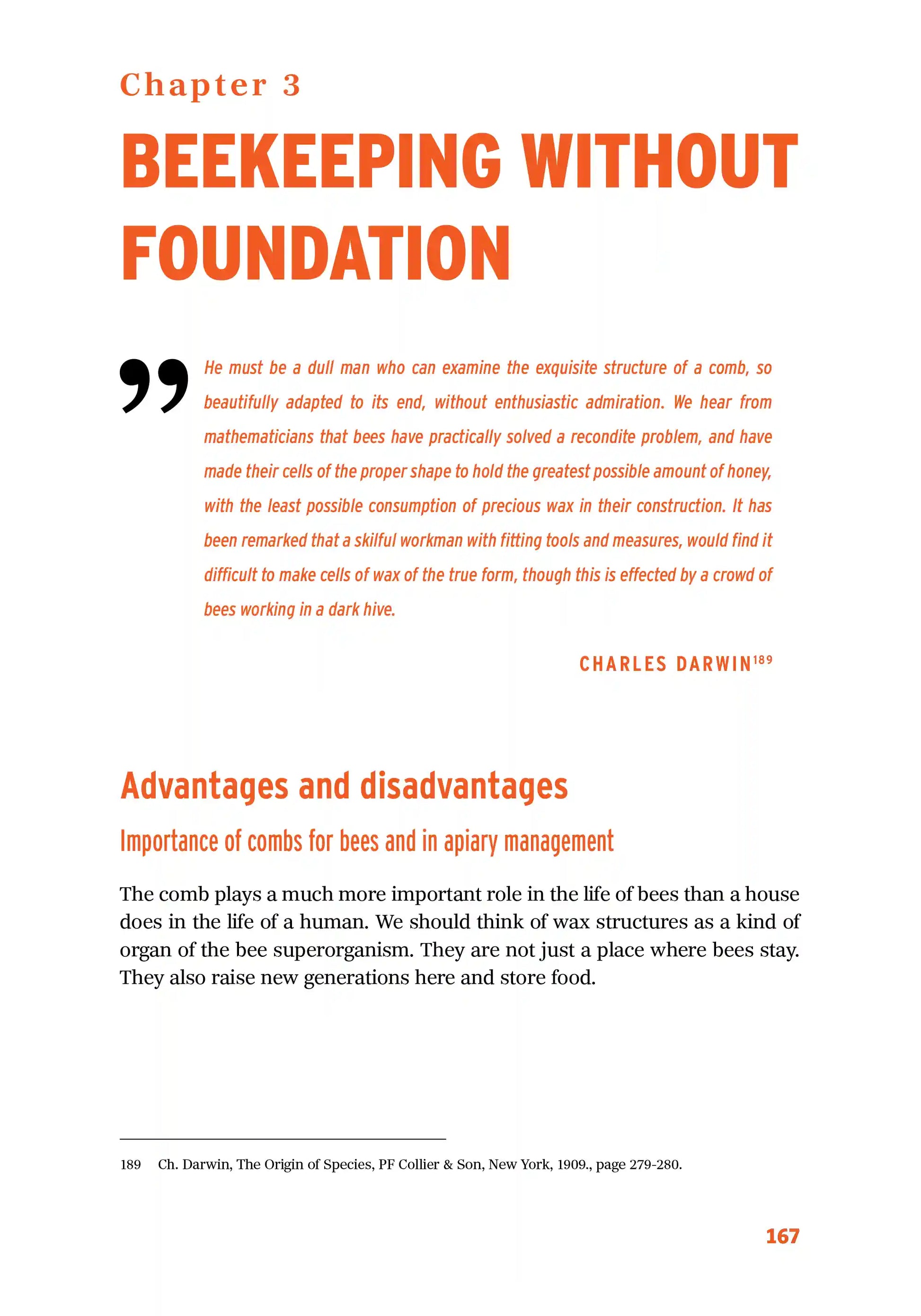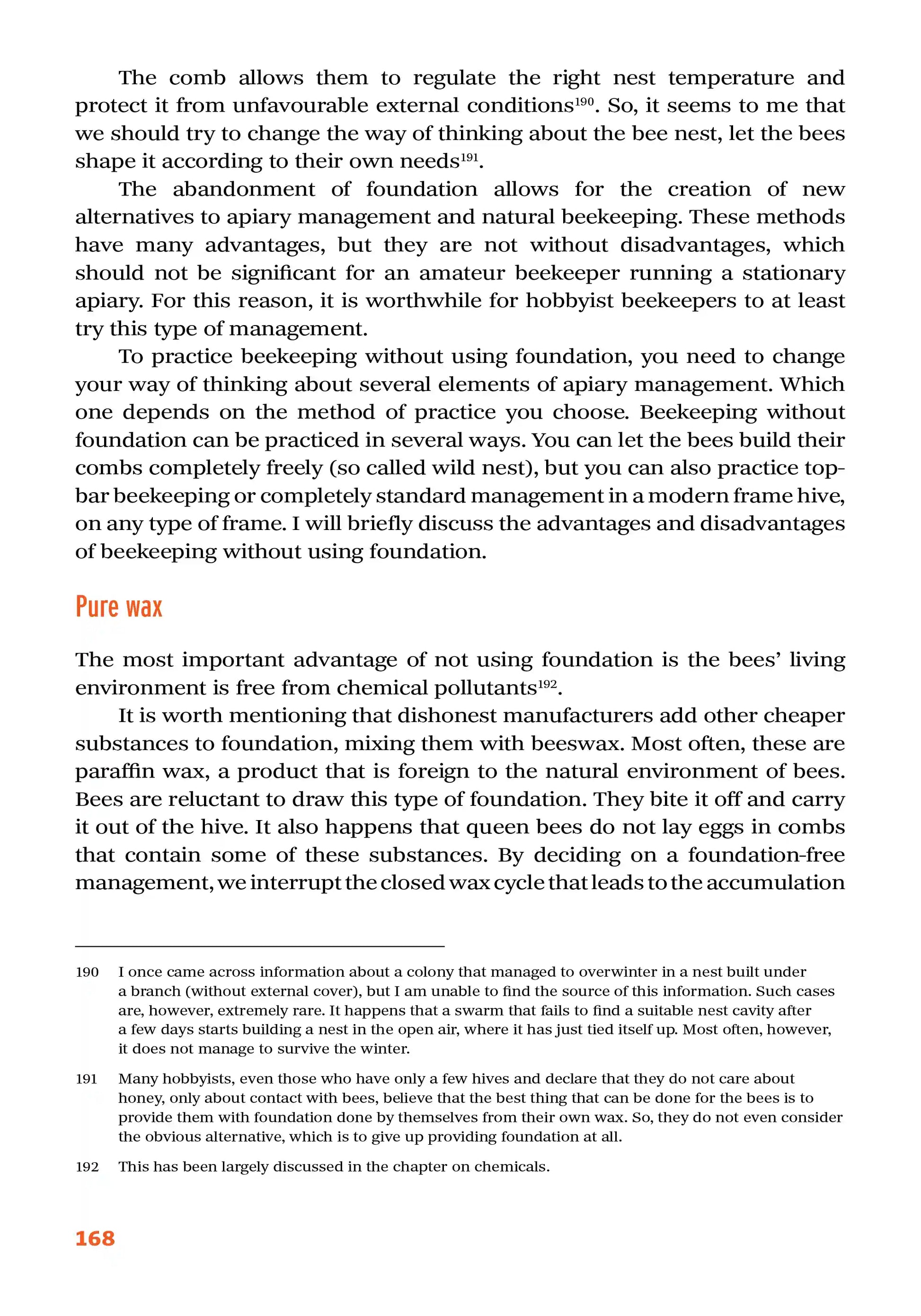Beekeeping in Harmony With Nature by Bartłomiej Maleta



Beekeeping in Harmony With Nature
We often forget that honeybees have been surviving millions of years before humans started to manage them. During that time they would have faced and overcome countless pests and pathogens without any help from us. The semi-domestication, global expansion and their exploitation for economic gain have no doubt accelerated the threats faced by honeybees, but our attempts to fix these problem often neglects the honeybees amazing adaptably. This timely book ‘Beekeeping in Harmony with Nature’ tries to redress the balance by showing that more ‘nature-based solution’ can provide a long-term solutions to various pests and diseases, particularly to the Varroa problem, that continues to plague beekeepers, especially in the Northern Hemisphere.
This is a hefty tome containing almost 400 beautifully illustrated pages. It contains six main chapters, covering Bee Health, Natural Bee Hives, Beekeeping Without Foundation, My Apiary, Bees and People, and Beekeeping without toxic substances. It is written by a beekeeper for beekeepers, and is very well researched. Even the most knowledgeable beekeepers will learn something new, such is the depth and breadth of the information provided. The clever use of almost 400 footnotes and bibliography allows the reader to go deeper into a subject, if they wish, without disrupting the flow of the main text. The book will appeal to anyone thinking of trying to move away from using varroa miticides as the book contains lots of practical advice, along with the supporting science. It will also be of interest to beekeepers wanting to keep their bees in a more natural way.
Bartłomiej Maleta (born 1979) a lawyer by education; once a policeman and instructor of Chinese martial arts, today a beekeeper and promoter of the principle of sustainable development and co-operation in the selection of varroa-resistant honey bees. Co-founder of beekeeping groups, including the "Bee Brotherhood" and the "Fort Knox" project, as well as forums bringing together enthusiasts of nature-based beekeeping. Advocate of the method of running an apiary in accordance with the biology of bees shaped during their evolution and the need to rebuild wild-living populations of honey bees. Publishes in the pages of 'Pszczelarstwo' (Polish Beekeeping Magazine).
VIEW Contents
- Introduction to the English Edition
- Note from the Translator
- Through the Professors’ Eyes
- Introduction
- Bee Health
- An alternative view
- The most dangerous diseases
- Investigating the causes of bee health problems
- Darwinian beekeeping
- Evolutionary perspective
- Bees in nature and bees in apiaries
- Observations and experiments
- Darwinian beekeeping principles - Conclusions
- Fighting against varroa - a road to nowhere
- Impact of treatments on the ecological system
- Principles of natural selection - ecological tolerance
- Virulence, horizontal and vertical transmission
- Disinfection of the bees’ nesting site
- Chemicals in the bee’s environment
- What are chemicals in beekeeping?
- Hard chemicals
- Soft chemicals
- Varroosis
- What kind of disease is this?
- Can bees cope with varroa?
- Are untreated bees a threat to the surrounding colonies?
- Project COMB
- Natural Bee Hives
- The strange choices of bees
- Bee preferences
- Properties of the natural nesting site
- Symbiotic organisms of bees – pseudoscorpions
- Natural bee hives - Conclusions
- Beekeeping Without Foundation
- Advantages and disadvantages
- Importance of combs for bees and in apiary management
- Pure wax
- Natural worker-cells
- Freedom to raise drones
- Saving time and money
- Disadvantages of foundation-free beekeeping
- Ways of keeping bees without foundation
- Natural comb
- Top-bar hives
- Frame hives
- Management without foundation in a frame hive
- Adding empty frames
- Placing the colony on empty frames, expanding the nest
- Frames with strips of foundation
- Slats glued to the upper bar of the frame
- The upper bars are planned to a point
- The upper bar of the frame is set vertically
- Leaving a few rows of old comb cells
- Attaching the comb strips to the frame
- Other advice
- Honey extraction from foundation-free combs
- Honey extraction by spinning
- Honey squeezing and section honey
- Efficiency of an apiary run without foundation
- Advantages and disadvantages
- My Apiary
- History of selection
- Bee hives
- The bee
- Expansion model beekeeping
- Artificial tree hives
- Ethics of not treating for varroa
- Bees and People
- Bee populations living around the world without varroa treatment
- Wild-living populations - is it a myth?
- Arnot Forest, New York, USA
- Pennsylvania, USA
- Arizona, USA
- Cuba
- Subspecies: Apis mellifera scutellata, Apis mellifera capensis
- Tunisian honey bees
- Fernando de Noronha, Brazil
- Primorsky Krai, Russian honey bees
- Gotland, Sweden
- Avignon and Le Mans, France
- The British Isles
- “Bartnicy Sudetów” Poland [Sudety Tree Beekeepers Program]
- “Fort Knox” project, Poland
- Beekeepers, enthusiasts, and bee lovers
- Subjective ranking
- Michael Bush, Nebraska, USA
- Dee Lusby, Arizona, USA
- Kirk Webster, Vermont, USA
- Sam Comfort, Florida and New York, USA
- Solomon Parker, Oregon, USA
- David Heaf, Great Britain (Wales)
- Jonathan Powell, Great Britain
- Norbert Dorn, Austria
- Erik Österlund, Sweden
- Juhani Lunden, Finland
- Torben Schiffer, Germany
- John Kefuss, France
- Other amateur beekeepers
- Poland
- Bee populations living around the world without varroa treatment
- At the Crossroads, or the Path to Beekeeping Without Toxic Substances
- Tools, characteristics, properties of bees, resistant traits
- Hygienic behaviour
- Varroa Sensitive Hygiene (VSH), recapping
- Suppressed Mite Reproduction (SMR)
- Grooming
- Attractiveness of the brood
- Shortening of the sealed brood phase
- Influence of natural brood breaks on mite population growth
- Social apoptosis
- Resistance to pathogens, individual and social immunity
- Local bees
- The transition period to beekeeping without treatments
- Transition period - what is it?
- Choosing a method in which selection for resistance is consistent with your existing beekeeping goals
- Gradual withdrawal from chemical treatments
- Selection of the traits needed for the bees to survive in the presence of the varroa mite
- Shaping the bees’ living environment and the ecological situation
- Stimulating the immune response of bees to pathogens
- Tools, characteristics, properties of bees, resistant traits
- Summary
- Bibliography
VIEW Book Review
Reviewed by Ann Chilcott (Scottish Expert Beemaster) and author of THE BEELISTENER
Beekeeping in Harmony with Nature: The Evolutionary Solution To The Varroa Problem by Bartołomiej Maleta is a well-argued perspicuous treatise on why we should stop using chemicals and instead allow the bees to combat varroa themselves. This is research-based science communication at its best and written in an engaging style. The translator is to be commended for making this work not only accessible to English speaking readers, but in a form that reads smoothly and clearly.
The author is a Polish beekeeper dedicated to cooperating with others to promote sustainable beekeeping and develop varroa resistant bees. He is the co-founder of several groups focussing on nature-based beekeeping that endeavour to manage apiaries as close to how honey bees would function in the wild without our assistance. Maleta also highlights the need to promote and rebuild colonies of free-living honey bees in our environments.
There are six chapters which are long but relate to particular themes and their subheadings are signposted in the content pages. The generous footnotes are particularly useful and help the reader keep easily on track without having to search an index at the end of the book.
The information flows in a logical order which I read from cover-to cover in almost one sitting because the content was so captivating, but one could also dip into this book for specific information. It is well illustrated with clear photographs, diagrams and tables. However, if there is to be a revised version, numbering chapters and using a different colour scheme for the contents pages would make navigation easier. White on an orange background is not easy for some people to read, especially with a small font size. Otherwise, the orange headings and page numbers stand out attractively in the body of the book. The front cover immediately attracts attention with the profile of Charles Darwin setting the scene for what follows.
Chapter 1 addresses bee health encompassing Darwinian beekeeping and highlighting the work by Professor Seeley on how honey bees live and survive in the wild without human intervention. We learn so much here about the evolutionary perspective and the differences between the environments of wild and managed colonies.
Chapter 2 deals with honey bee homes and how beekeepers can provide similar accommodation to what our colonies would choose themselves if they could. It is quite alarming to realise how much we unwittingly alter the hive environment and interfere with the natural defences of its microbiome when we use harsh natural acids such as oxalic acid. Oxalic acid not only kills varroa but also good bacteria and fungus crucial for healthy natural immunity to disease.
Chapter 3 covers the internal hive structure and discusses all aspects of foundation and foundation-free beekeeping highlighting the advantages and disadvantages of each method.
In Chapter 4 we discover what inspired Maleta’s journey into beekeeping without chemicals and we learn from the accounts of his own beekeeping challenges.
Chapter 5 is a journey across the world examining populations of honey bees living without varroa treatments and why they do. We discover the influencing dynamics and the differences and similarities between these populations. It also features some of the pioneering beekeepers who have impressed the author by their successes in varied settings.
The final chapter explains what varroa resistant traits are and how we can transition to treatment-free beekeeping. Maleta draws on research and the experiences of many other beekeepers to inform us in a helpful non-prescriptive way. He raises awareness, presents the facts, and encourages the individual beekeeper to choose for themselves the best way forward.
Maleta has reached beyond his aim; “My goal is to popularise knowledge about natural methods of keeping and breeding bees and to show a different perspective”. This is a very important publication and relevant to every beekeeper whether or not they intend to pursue treatment-free beekeeping.
Unavailable